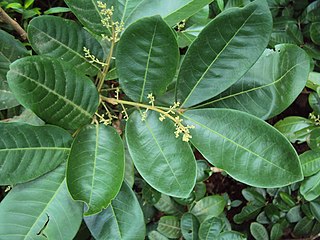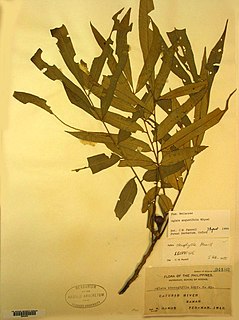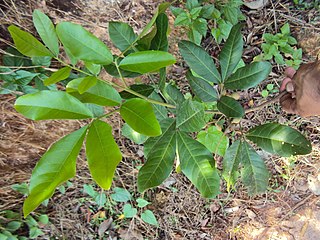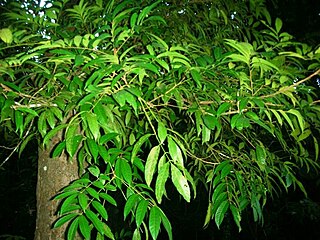
Aglaia is a genus of 117 species of woody dioecious trees belonging to the Mahogany family (Meliaceae). These trees occur in the subtropical and tropical forests of Southeast Asia, Northern Australia and the Pacific.

Aglaia angustifolia is a species of plant in the family Meliaceae. It is found in Brunei, Indonesia, Malaysia, and the Philippines.

Aglaia argentea is commonly known as Silver Boodyara, Bekak, or Koping-koping. [5] It is a tropical wild grown evergreen native to Australia, throughout East Asia and in several Pacific islands.[6]
Aglaia densitricha is a species of plant in the family Meliaceae. It is a tree endemic to Peninsular Malaysia.

Aglaia edulis is a tree species of plant in the family Meliaceae. It occurs in Tropical Asia from India to Yunnan and South-Central China. The wood and timber are used for various purposes.

Aglaia elaeagnoidea, the droopy leaf or priyangu, is a species of plant in the family Meliaceae. It is a 10m tall tree found in American Samoa, Australia, Cambodia, India, Indonesia, Malaysia, New Caledonia, Papua New Guinea, the Philippines, Samoa, Sri Lanka, Taiwan, Thailand, Vanuatu, and Vietnam.
Aglaia foveolata is a species of tropical tree in the family Meliaceae. This plant occurs in Brunei, Indonesia, and Malaysia. It produces edible fruit. The bark contains silvestrol which is a potent inhibitor of ebola virus and Zika Virus replication.
Aglaia glabrata is a species of plant in the family Meliaceae. Aglaia glabrata is native to Brunei, Indonesia, and Malaysia.

Aglaia lawii is a species of tree in the family Meliaceae. As well as the autonym species, there are two subspecies accepted.
Aglaia leptantha is a species of tree in the family Meliaceae. It is found in Mainland and Island Southeast Asia. People use the plant for food, incense, and for human and bovine medicine. Gibbons also eat parts of the tree.
Aglaia macrostigma is a species of plant in the family Meliaceae. It is a tree endemic to Peninsular Malaysia.
Aglaia odoratissima is a species of plant in the family Meliaceae. It is found in Brunei, India, Indonesia, Malaysia, Myanmar, the Philippines, Singapore, and Thailand.
Aglaia oligophylla is a species of plant in the family Meliaceae. It is found in Brunei, India, Indonesia, Malaysia, the Philippines, Singapore, and Thailand.
Aglaia perviridis is a species of plant in the family Meliaceae. It is found in Bangladesh, Bhutan, China, India, Malaysia, Thailand, and Vietnam.
Aglaia rufinervis is a species of tree in the family Meliaceae. It is native to Thailand, Peninsular Malaysia, Singapore, Sumatra, Borneo and Java.
Aglaia scortechinii is a species of plant in the family Meliaceae. It is found in Brunei, Indonesia, and Malaysia.
Aglaia speciosa is a species of plant in the family Meliaceae. It is found in Indonesia and Malaysia.

Aglaia spectabilis is a species of tree in the family Meliaceae, found from the Santa Cruz Islands in the southwest Pacific to Queensland (Australia), Southeast Asia, Yunnan (Zhōngguó/China) and the Indian subcontinent. It grows from a 1m shrub to an emergent 40m tall tree, depending on the habitat. Its wood is commercially exploited as timber, but otherwise is of poor quality with limited use. The fruit are eaten, and used in folk medicine. The seeds are large in comparison to other plants, and a major source of dispersal of the species are hornbills eating the fruit, flying away from the tree and regurgitating the seeds.

Aglaia tomentosa is a species of plant in the family Meliaceae. It is found in Australia (Queensland), Brunei, India, Indonesia, Laos, Malaysia, Papua New Guinea, the Philippines, Singapore, and Vietnam.
Pentace laxiflora is a species of flowering plant in the family Malvaceae sensu lato or Tiliaceae. It is a tree endemic to Borneo. Its conservation status has been listed by the International Union for Conservation of Nature as being of least concern.








